Carbon cheat sheet by 2050 Materials

Carbon is a source of life as well as a threat to humanity
How to use the cheat sheet
This cheat sheet for carbon defines common jargon around the topic of carbon emissions, explains what carbon is, how it contributes to climate change and is meant to help designers and construction professionals understand carbon and use it to tackle the issue.
You can read this as an article, or you can save the link and look up terminologies whenever you need them.
 If you are looking for terminologies that you can’t find, email us at info@2050-materials.com and we’ll make sure to add them to this cheat sheet.
If you are looking for terminologies that you can’t find, email us at info@2050-materials.com and we’ll make sure to add them to this cheat sheet.
Carbon, the element
Carbon is the 15th most abundant element in the Earth’s crust, and the fourth most abundant element in the universe by mass. On earth, it’s found in almost everything, from diamonds to coal and to about a fifth of the human body.
Carbon cycle
Carbon is endlessly circulated between land, sea and sky. Plants and animals take up carbon, and then release it again when they die, in the atmosphere, on earth (in sedimentary rocks or fossil deposits) or in the ocean.
Human activity, in particular the burning of fossil fuels, transfers carbon that was once contained in living creatures and plants into the atmosphere. This activity is disrupting the natural carbon cycle.
Carbon sinks
A carbon sink is anything that absorbs more carbon from the atmosphere than it releases — for example, plants, the ocean and soil.
Carbon sources
Carbon sources are any natural or artificial production site of carbon. For example, the burning of fossil fuels, forest fires, animal respiration, and plant degradation are all sources of carbon.
Carbon dioxide (CO2)
Carbon dioxide is a gas consisting of one part carbon and two parts oxygen. It is one of the most important gases on the earth because plants use it to produce carbohydrates in a process called photosynthesis. Since humans and animals depend on plants for food, photosynthesis is necessary for the survival of life on earth.
You have probably heard of CO2 emissions in the news regarding global warming. As CO2 builds up in our atmosphere from burning fossil fuels, it has a warming effect that is changing the earth’s climate.
Carbon dioxide equivalent (CO2e)
Carbon dioxide equivalent (CO2e) is a measure that allows various greenhouse gases to be compared in terms of their contribution to global warming.
Global Warming Potential
A kg of the carbon dioxide equivalent of a given gas has the same warming effect as a kg of CO2. This can be identified by studying the global warming potential (GWP) of each gas, taking into account the length of time it remains in the atmosphere, and comparing this to the global warming potential of CO2 (which is equal to 1).
Methane, the commonly used “gas” for electricity and heating has a GWP of 25, meaning that 1 tonne of methane has the same climate impact as 25 tonnes of carbon dioxide.
 Global Warming Potential of a few greenhouse gases used in construction:
HFC-23 (used as a refrigerant and a fire suppressant) → GWP of 14 800
Sulphur hexafluoride (used as an electrical insulator) → GWP of 22 800
Global Warming Potential of a few greenhouse gases used in construction:
HFC-23 (used as a refrigerant and a fire suppressant) → GWP of 14 800
Sulphur hexafluoride (used as an electrical insulator) → GWP of 22 800
Greenhouse Gas Emissions
Greenhouse gas emissions (aka GHG emissions or carbon emissions) are greenhouse gases that are emitted to the Earth’s atmosphere because of humans. These gases are the underlying reason behind climate change. Most emissions come from burning fossil fuels: coal, oil, and natural gas.
The construction sector is responsible for 39% of all greenhouse gas emissions globally, with 11% coming from the manufacturing of building materials such as steel, concrete and glass.
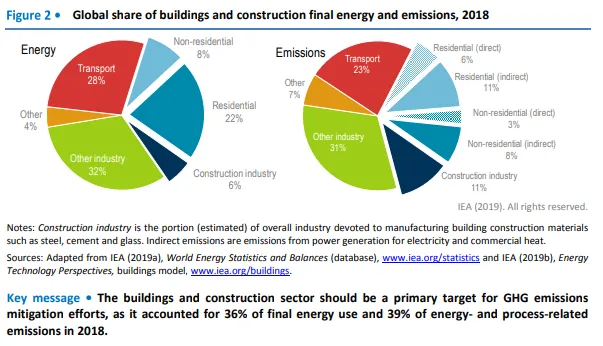
Atmospheric carbon dioxide
Atmospheric CO2 describes the total amount of CO2 in the atmosphere, adding natural and human-induced emissions.
Carbon parts per million (PPM) in the atmosphere has risen from 280 in pre-industrial times to 416 during the time of writing according to NASA.
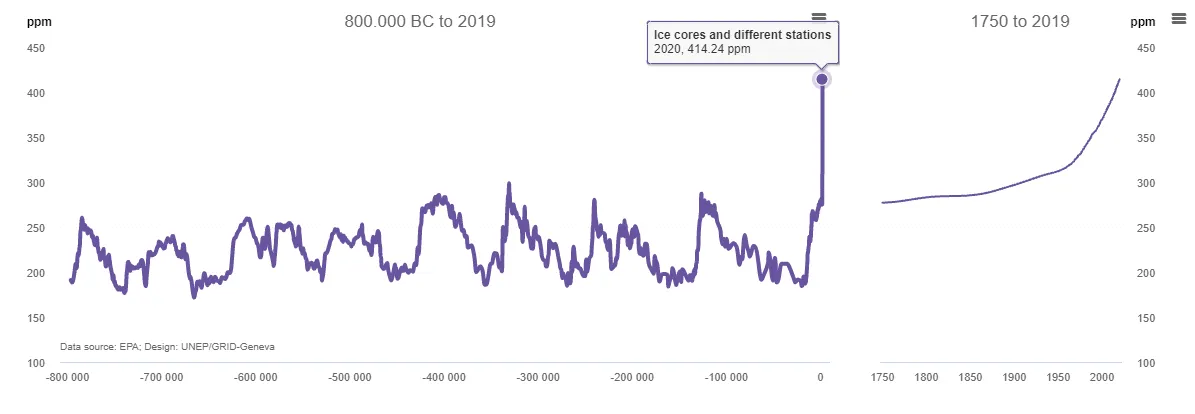
Carbon footprint
Carbon footprint is the amount of carbon dioxide released into the atmosphere as a result of the activities of a particular individual, organization, or community. This number is often reported on a yearly basis in the units of CO2e.
Biogenic vs Fossil carbon emissions
Biogenic carbon emissions are those that originate from biological sources such as plants, trees, and soil. Biogenic carbon emissions relate to the natural carbon cycle, as well as those resulting from the combustion, harvest, digestion, fermentation, decomposition or processing of biologically based materials.
Fossil carbon emissions refer to emissions that originate from the burning of fossil fuels and would not be released in the absence of human activity.
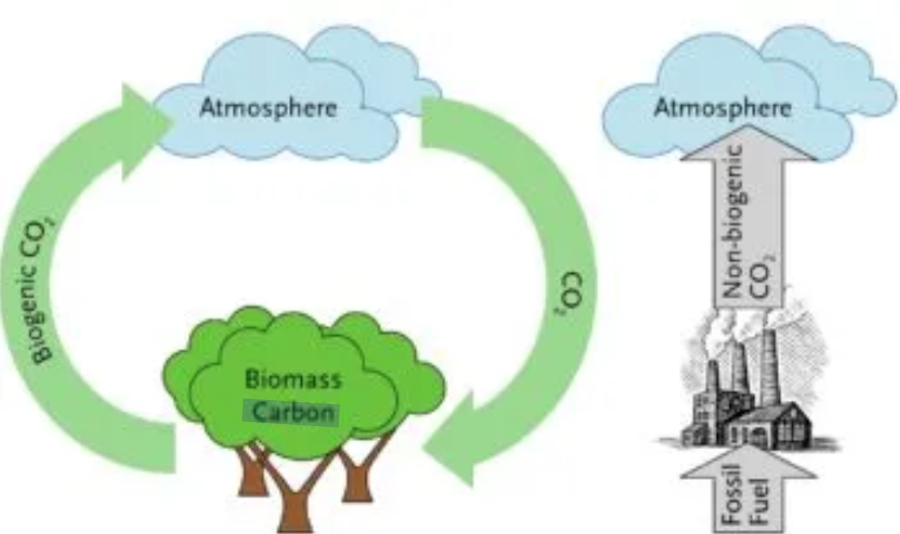
Direct & Indirect Emissions
Direct GHG emissions are emissions from sources that are owned or controlled by the reporting entity.
Indirect GHG emissions are emissions that are a consequence of the activities of the reporting entity, but occur at sources owned or controlled by another entity.
Emission Scopes
The GHG Protocol futher categorizes direct and indirect emissions into three broad scopes:
- Scope 1: All direct GHG emissions.
- Scope 2: Indirect GHG emissions from consumption of purchased electricity, heat or steam.
- Scope 3: Other indirect emissions, such as the extraction and production of purchased materials and fuels, transport-related activities in vehicles not owned or controlled by the reporting entity, electricity-related activities (e.g. T&D losses) not covered in Scope 2, outsourced activities, waste disposal, etc.
Embodied carbon
Embodied carbon is all the CO2 emitted in producing materials. It’s estimated from the energy used to extract and transport raw materials as well as emissions from manufacturing processes.
The embodied carbon of a building includes all carbon emissions generated by the extraction and processing of natural materials plus the manufacturing, transportation and construction or assembly of the building, as well as the emissions related to the deconstruction and disposal of components at the end of the building’s life.
Operational carbon
Operational carbon refers to the total carbon emitted from all energy sources used to keep our buildings warm, cool, ventilated and lit, or to put it simply, powered.
Typical energy sources for this purpose are electricity and natural gas, with less frequent contributions from fuels such as oil, propane and wood.
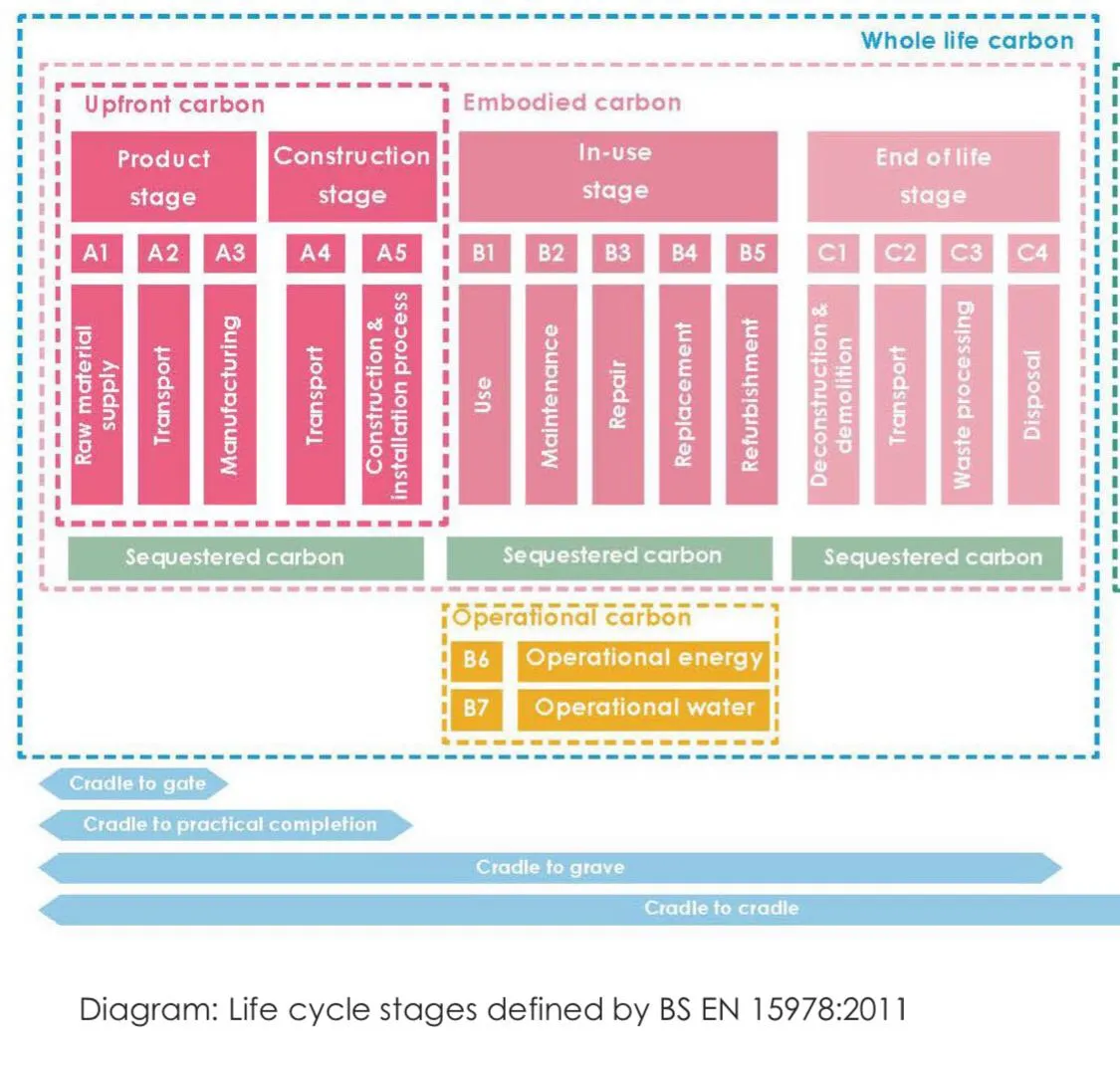
Carbon Budgets
The concept of the carbon budget is based on a nearly linear relationship between the cumulative CO2 emissions and the temperature rise.
Carbon budgets are total amounts of cumulative emissions that scientists estimate can be emitted without reaching certain levels of global warming. These are useful for governments and regulators to set strategies for CO2e reductions in each industry.
1.5°C / 2°C Warming
In order to measure the effect of climate change and global warming, scientists track the additional warming of the planet compared to pre-industrialized times.
Two metrics which are often reported on are 1.5°C and 2°C warming. These refer to the average temperature on earth being 1.5°C or 2°C warmer in 2100, than it was in pre-industrialized times and are important thresholds as they represent irreversible changes to the climate and to human health.
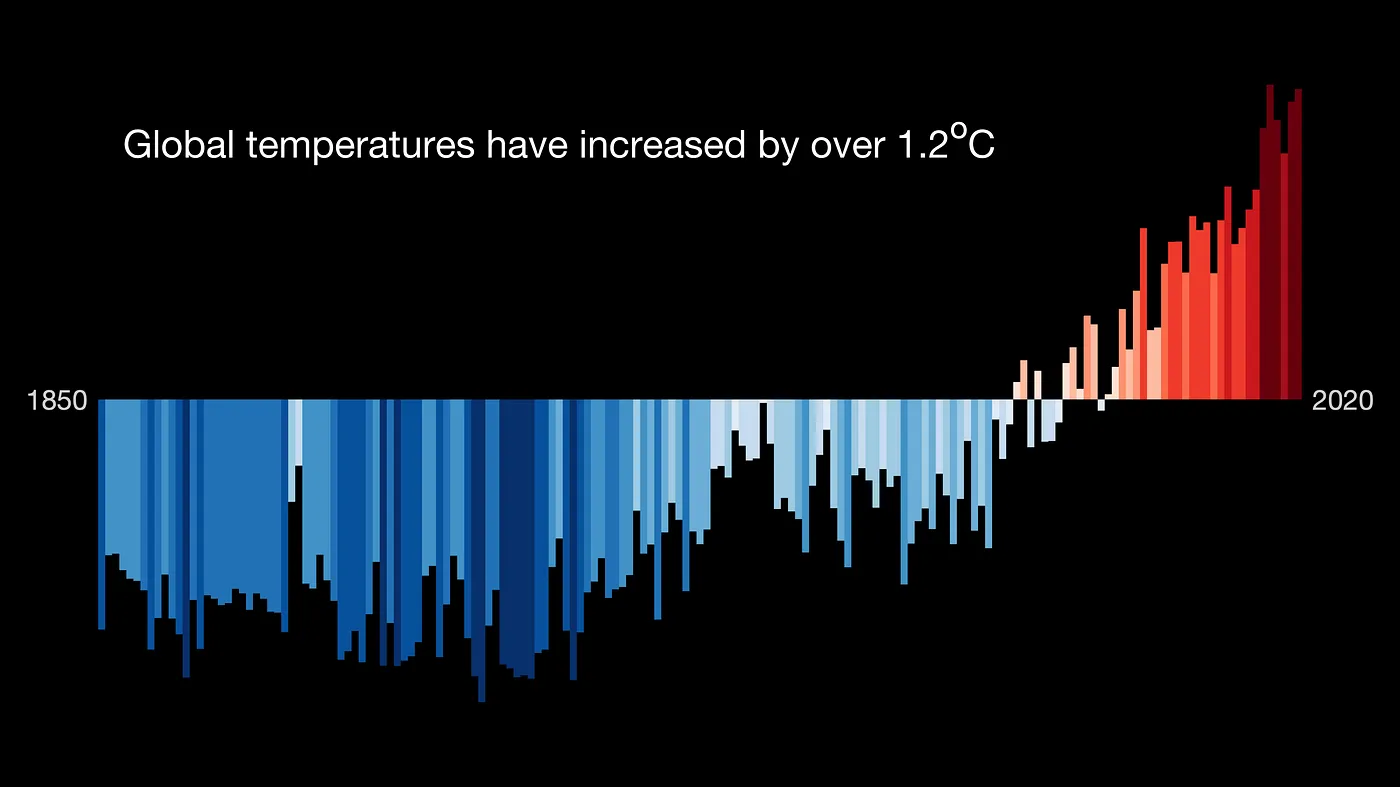
“Show me your stripes” project by the University of Reading
Carbon calculators and carbon auditing
Carbon calculators aim to help organisations and individuals estimate and reduce or offset their carbon footprints.
Reductions in the built environment can be done through low-energy buildings, switching to renewable power sources and using sustainable building materials. Companies and individuals can also offset their emissions to reduce their carbon footprint(see below).
Carbon offsetting
A carbon offset broadly refers to a reduction in GHG emissions — or an increase in carbon storage (e.g., through land restoration or the planting of trees) — that is used to compensate for emissions that occur elsewhere.
A carbon offset credit is a transferable instrument certified by governments or independent certification bodies to represent an emission reduction of one metric tonne of CO2, or an equivalent amount of other GHGs. The purchaser of an offset credit can “retire” it to claim the underlying reduction towards their own GHG reduction goals.
The Oxford Principles for Net Zero Aligned Carbon Offsetting provides a guide to offsetting approaches to align with the concept of net-zero emissions
Carbon neutrality
Carbon-neutrality (or being carbon neutral) is the balance between emitting carbon and absorbing carbon emissions from carbon sinks. Or simply, elimination of all carbon emissions altogether.
According to the European Union Commission, natural sinks remove between 9.5 and 11 Gt of CO2 per year. To date, no artificial carbon sinks can remove carbon from the atmosphere on the necessary scale to fight global warming. Hence, to become carbon-neutral, companies have two options:
- Reducing drastically their carbon emissions to net-zero
- Balancing their emissions through offsetting and the purchase of carbon credits.
Climate positive
Climate positive means that activity goes beyond achieving net-zero carbon emissions to create an environmental benefit by removing additional carbon dioxide from the atmosphere.
Carbon negativity and carbon positivity
Carbon negative is the same as “climate positive.”
Carbon positive is how organisations describe climate positive and carbon negative. It’s mainly a marketing term, and understandably confusing.
The UN’s Race to Zero initiative prefers the term “carbon positive” but the architecture and construction sectors have largely adapted the term “carbon negative”.
Climate neutral
Climate neutral refers to reducing all GHG to the point of zero while eliminating all other negative environmental impacts that an organisation may cause.
Net-Zero
Net-Zero carbon emissions mean that an activity releases net-zero carbon emissions into the atmosphere.
Net-Zero emissions balance the whole amount of greenhouse gas (GHG) released and the amount removed from the atmosphere.
Carbon trading
Carbon trading is the buying and selling of credits that permit a company or other entity to emit a certain amount of carbon dioxide. The carbon credits and the carbon trade are authorized by governments with the goal of gradually reducing overall carbon emissions and mitigating their contribution to climate change.
Carbon capture and storage
Carbon capture and storage (CCS) (aka carbon capture and sequestration) is the process of capturing carbon dioxide (CO2) before it enters the atmosphere, transporting it, and storing it (carbon sequestration) for centuries or millennia.
Usually the CO2 is captured from large point sources, such as a chemical plant or biomass power plant, and then stored in an underground geological formation. The aim is to prevent the release of CO2 from heavy industry with the intent of mitigating the effects of climate change.
About us
2050 Materials is a team of sustainability experts, architects and construction professionals. We’re building a platform to help designers navigate the complexity of climate issues in the construction sector.
If you would like to stay updated on our progress and get notified when we launch, register on our website, or follow us on LinkedIn.
Phanos , Co-Founder
Related articles

Climate-Resilient Materials for the Built Environment: A Data-Centred Prime
As climate volatility intensifies, resilience metrics are fast becoming as critical as carbon data in material selection. This article outlines why adaptation is now a design imperative, how materials can be evaluated through a systems lens, and what KPIs project teams should demand. From self-healing concrete to fire-rated façades, we present a structured taxonomy of resilient materials, explain how to embed this intelligence into digital design workflows, and propose next steps for specification, benchmarking, and procurement.
Read more
The Most Interesting Low Carbon Products in Office Design
In this article and collection, we highlight 11 outstanding products that contribute to a lower carbon footprint in office design.
Read more
Top Low Carbon Building Boards: Performance, Benefits, and Use Cases
The building boards highlighted in this article and collection showcase low-carbon innovation in modern construction.
Read more